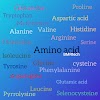Tyrosin | Introduction | History | Stucture.....
Tyrosin Amino Acid
Introduction-
Tyrosin or 4-hydroxyphenylalanine is
non-essential amino acid. It is one of the 20 standard amino acids that are
used by cells to synthesize
proteins. It is a polar side group. The word "tyrosine" is from the Greek tyrós, meaning cheese, as it was first discovered in 1846 by German
chemist Justus von Liebig in the
protein casein from cheese. It is
called tyrosyl when referred to as a functional
group or side chain. While tyrosine is
generally classified as a hydrophobic amino
acid, it is more hydrophilic than phenylalanine. It is encoded by
the codons UAC and UAU in messenger
RNA.
History-
It was first discovered in 1846 by German chemist Justus von Liebig in the protein casein from cheese.
Properties :-
Chemical formula :- C9H11NO3
Molar mass :- 181.191 g·mol−1
Solubility in water :- .0453 g/100 mL
Thermodynamic data :- Phase behaviour (solid–liquid–gas)
Structure-
Sources-
Tyrosine, which can also be synthesized in the body from phenylalanine, is found in many high-protein food products such as chicken, turkey, fish, milk, cheese..etc
Biosynthesis-
In plants and most microorganisms, tyr is
produced via prephenate, an
intermediate on the shikimate pathway.
Prephenate is oxidatively decarboxylated with
retention of the hydroxyl group to
give p-hydroxyphenylpyruvate, which is transaminated using glutamate as
the nitrogen source to give tyrosine and α-ketoglutarate.
Mammals synthesize tyrosine from the essential amino acid phenylalanine (phe), which is derived from food.
Industrial synthesis-
L-tyrosine and its derivatives are used
in pharmaceuticals, dietary supplements,
and food additives. Two methods were
formerly used to manufacture L-tyrosine. The first involves the extraction of
the desired amino acid from protein hydrolysates using a chemical approach. The
second utilizes enzymatic synthesis from phenolics, pyruvate, and ammonia.
Function-
· Proteinogenic
amino acid.
· Tyrosine has a
special role by phenol functionality.
· It occurs in
proteins that are part of signal transduction processes and functions as a receiver of phosphate
groups that are transferred by way of protein kinases.
· Phosphorylation of
the hydroxyl group can change the activity of the target protein, or may form
part of a signaling cascade via SH2 domain binding.
· A tyrosine residue
also plays an important role in photosynthesis.
· Chloroplasts it acts as an electron donor in the reduction
of oxidized chlorophyll.
· In this process, it
loses the hydrogen atom of its phenolic OH-group.
· This radical is
subsequently reduced in the photosystem II by the four core manganese clusters.








0 Comments